Impact of Social Media Marketing on Consumer Buying: M&S Analysis
VerifiedAdded on 2023/01/10
|7
|1877
|81
Literature Review
AI Summary
This literature review investigates the impact of social media marketing on consumer buying behavior within the retail sector, specifically focusing on Marks & Spencer (M&S). The report begins with an introduction to social media marketing, highlighting its role in promoting products and increasing customer bases. The main body delves into the benefits of social media marketing, such as increased exposure and brand awareness, while also acknowledging its drawbacks, including time intensiveness and security risks. The review then examines the effect of social media marketing on consumer behavior, discussing the stages of the consumer buying process (problem recognition, information search, evaluation of alternatives, purchase decision, and post-purchase evaluation) and how social media influences each stage. The review references several studies and models to support its arguments. The conclusion summarizes the importance of social media marketing as a key tool for marketing and promoting products, emphasizing its impact on consumer behavior and the retail sector, and ultimately highlights its effectiveness in modern marketing strategies. The review also provides references to the sources used in the analysis.

Literature Review
Paraphrase This Document
Need a fresh take? Get an instant paraphrase of this document with our AI Paraphraser
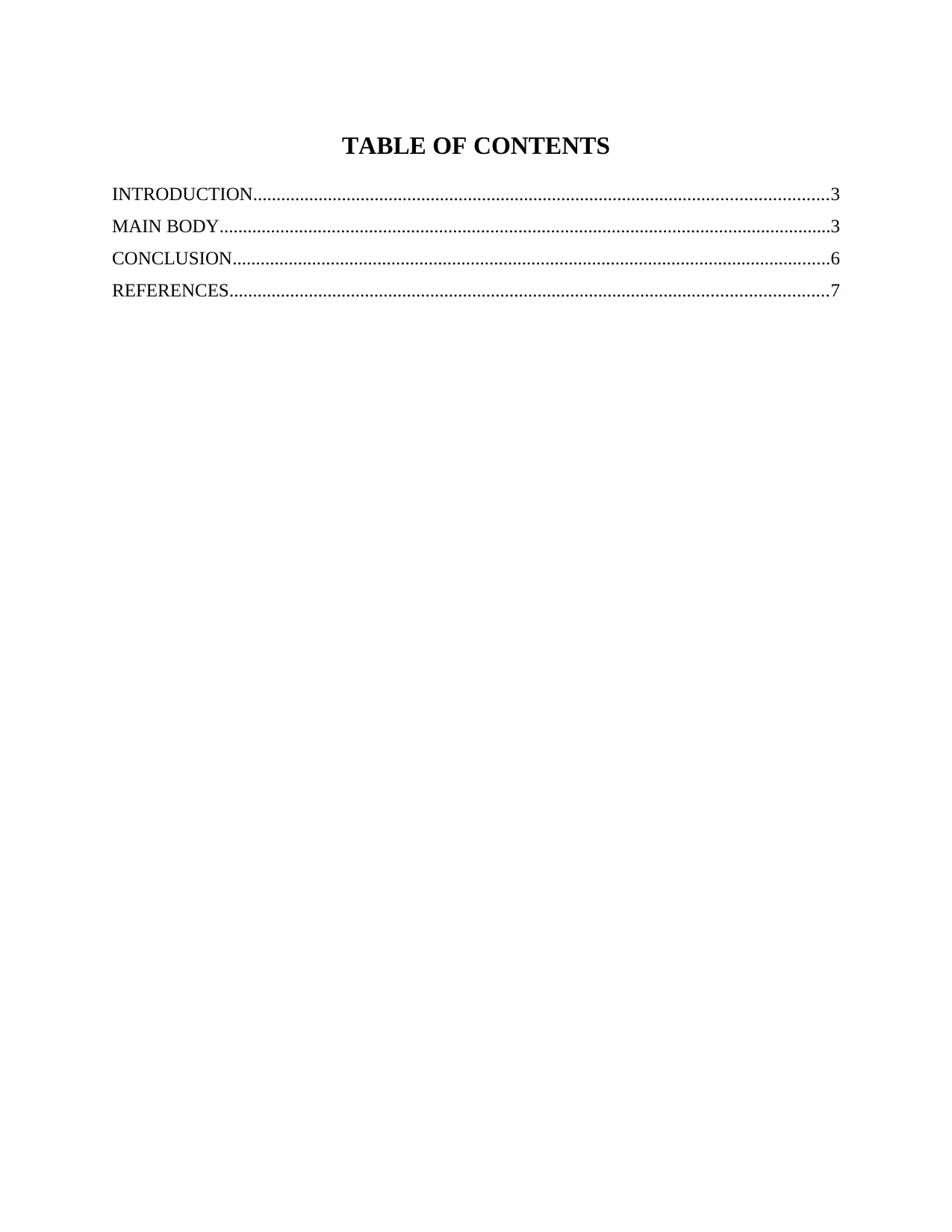
TABLE OF CONTENTS
INTRODUCTION...........................................................................................................................3
MAIN BODY...................................................................................................................................3
CONCLUSION................................................................................................................................6
REFERENCES................................................................................................................................7
INTRODUCTION...........................................................................................................................3
MAIN BODY...................................................................................................................................3
CONCLUSION................................................................................................................................6
REFERENCES................................................................................................................................7
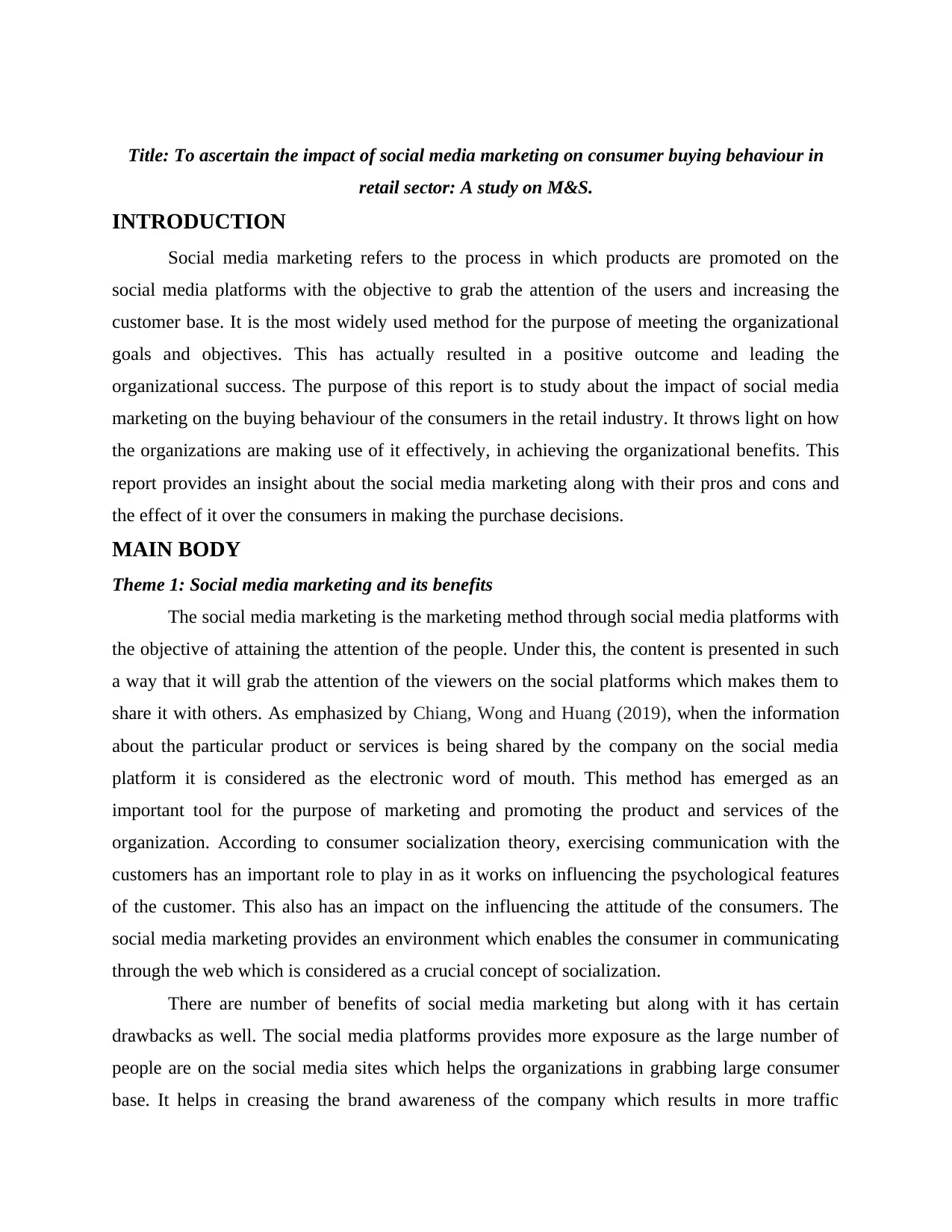
Title: To ascertain the impact of social media marketing on consumer buying behaviour in
retail sector: A study on M&S.
INTRODUCTION
Social media marketing refers to the process in which products are promoted on the
social media platforms with the objective to grab the attention of the users and increasing the
customer base. It is the most widely used method for the purpose of meeting the organizational
goals and objectives. This has actually resulted in a positive outcome and leading the
organizational success. The purpose of this report is to study about the impact of social media
marketing on the buying behaviour of the consumers in the retail industry. It throws light on how
the organizations are making use of it effectively, in achieving the organizational benefits. This
report provides an insight about the social media marketing along with their pros and cons and
the effect of it over the consumers in making the purchase decisions.
MAIN BODY
Theme 1: Social media marketing and its benefits
The social media marketing is the marketing method through social media platforms with
the objective of attaining the attention of the people. Under this, the content is presented in such
a way that it will grab the attention of the viewers on the social platforms which makes them to
share it with others. As emphasized by Chiang, Wong and Huang (2019), when the information
about the particular product or services is being shared by the company on the social media
platform it is considered as the electronic word of mouth. This method has emerged as an
important tool for the purpose of marketing and promoting the product and services of the
organization. According to consumer socialization theory, exercising communication with the
customers has an important role to play in as it works on influencing the psychological features
of the customer. This also has an impact on the influencing the attitude of the consumers. The
social media marketing provides an environment which enables the consumer in communicating
through the web which is considered as a crucial concept of socialization.
There are number of benefits of social media marketing but along with it has certain
drawbacks as well. The social media platforms provides more exposure as the large number of
people are on the social media sites which helps the organizations in grabbing large consumer
base. It helps in creasing the brand awareness of the company which results in more traffic
retail sector: A study on M&S.
INTRODUCTION
Social media marketing refers to the process in which products are promoted on the
social media platforms with the objective to grab the attention of the users and increasing the
customer base. It is the most widely used method for the purpose of meeting the organizational
goals and objectives. This has actually resulted in a positive outcome and leading the
organizational success. The purpose of this report is to study about the impact of social media
marketing on the buying behaviour of the consumers in the retail industry. It throws light on how
the organizations are making use of it effectively, in achieving the organizational benefits. This
report provides an insight about the social media marketing along with their pros and cons and
the effect of it over the consumers in making the purchase decisions.
MAIN BODY
Theme 1: Social media marketing and its benefits
The social media marketing is the marketing method through social media platforms with
the objective of attaining the attention of the people. Under this, the content is presented in such
a way that it will grab the attention of the viewers on the social platforms which makes them to
share it with others. As emphasized by Chiang, Wong and Huang (2019), when the information
about the particular product or services is being shared by the company on the social media
platform it is considered as the electronic word of mouth. This method has emerged as an
important tool for the purpose of marketing and promoting the product and services of the
organization. According to consumer socialization theory, exercising communication with the
customers has an important role to play in as it works on influencing the psychological features
of the customer. This also has an impact on the influencing the attitude of the consumers. The
social media marketing provides an environment which enables the consumer in communicating
through the web which is considered as a crucial concept of socialization.
There are number of benefits of social media marketing but along with it has certain
drawbacks as well. The social media platforms provides more exposure as the large number of
people are on the social media sites which helps the organizations in grabbing large consumer
base. It helps in creasing the brand awareness of the company which results in more traffic
⊘ This is a preview!⊘
Do you want full access?
Subscribe today to unlock all pages.

Trusted by 1+ million students worldwide
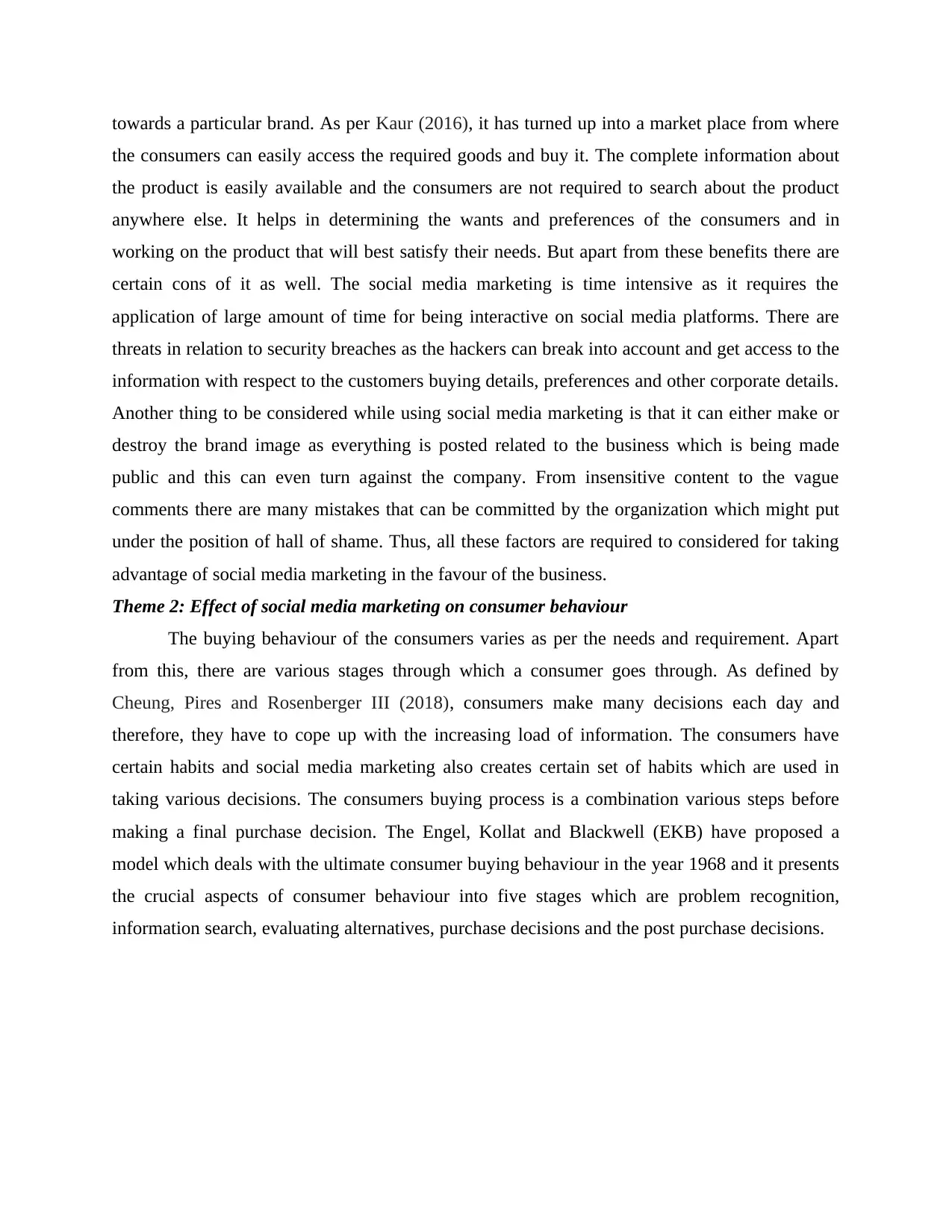
towards a particular brand. As per Kaur (2016), it has turned up into a market place from where
the consumers can easily access the required goods and buy it. The complete information about
the product is easily available and the consumers are not required to search about the product
anywhere else. It helps in determining the wants and preferences of the consumers and in
working on the product that will best satisfy their needs. But apart from these benefits there are
certain cons of it as well. The social media marketing is time intensive as it requires the
application of large amount of time for being interactive on social media platforms. There are
threats in relation to security breaches as the hackers can break into account and get access to the
information with respect to the customers buying details, preferences and other corporate details.
Another thing to be considered while using social media marketing is that it can either make or
destroy the brand image as everything is posted related to the business which is being made
public and this can even turn against the company. From insensitive content to the vague
comments there are many mistakes that can be committed by the organization which might put
under the position of hall of shame. Thus, all these factors are required to considered for taking
advantage of social media marketing in the favour of the business.
Theme 2: Effect of social media marketing on consumer behaviour
The buying behaviour of the consumers varies as per the needs and requirement. Apart
from this, there are various stages through which a consumer goes through. As defined by
Cheung, Pires and Rosenberger III (2018), consumers make many decisions each day and
therefore, they have to cope up with the increasing load of information. The consumers have
certain habits and social media marketing also creates certain set of habits which are used in
taking various decisions. The consumers buying process is a combination various steps before
making a final purchase decision. The Engel, Kollat and Blackwell (EKB) have proposed a
model which deals with the ultimate consumer buying behaviour in the year 1968 and it presents
the crucial aspects of consumer behaviour into five stages which are problem recognition,
information search, evaluating alternatives, purchase decisions and the post purchase decisions.
the consumers can easily access the required goods and buy it. The complete information about
the product is easily available and the consumers are not required to search about the product
anywhere else. It helps in determining the wants and preferences of the consumers and in
working on the product that will best satisfy their needs. But apart from these benefits there are
certain cons of it as well. The social media marketing is time intensive as it requires the
application of large amount of time for being interactive on social media platforms. There are
threats in relation to security breaches as the hackers can break into account and get access to the
information with respect to the customers buying details, preferences and other corporate details.
Another thing to be considered while using social media marketing is that it can either make or
destroy the brand image as everything is posted related to the business which is being made
public and this can even turn against the company. From insensitive content to the vague
comments there are many mistakes that can be committed by the organization which might put
under the position of hall of shame. Thus, all these factors are required to considered for taking
advantage of social media marketing in the favour of the business.
Theme 2: Effect of social media marketing on consumer behaviour
The buying behaviour of the consumers varies as per the needs and requirement. Apart
from this, there are various stages through which a consumer goes through. As defined by
Cheung, Pires and Rosenberger III (2018), consumers make many decisions each day and
therefore, they have to cope up with the increasing load of information. The consumers have
certain habits and social media marketing also creates certain set of habits which are used in
taking various decisions. The consumers buying process is a combination various steps before
making a final purchase decision. The Engel, Kollat and Blackwell (EKB) have proposed a
model which deals with the ultimate consumer buying behaviour in the year 1968 and it presents
the crucial aspects of consumer behaviour into five stages which are problem recognition,
information search, evaluating alternatives, purchase decisions and the post purchase decisions.
Paraphrase This Document
Need a fresh take? Get an instant paraphrase of this document with our AI Paraphraser
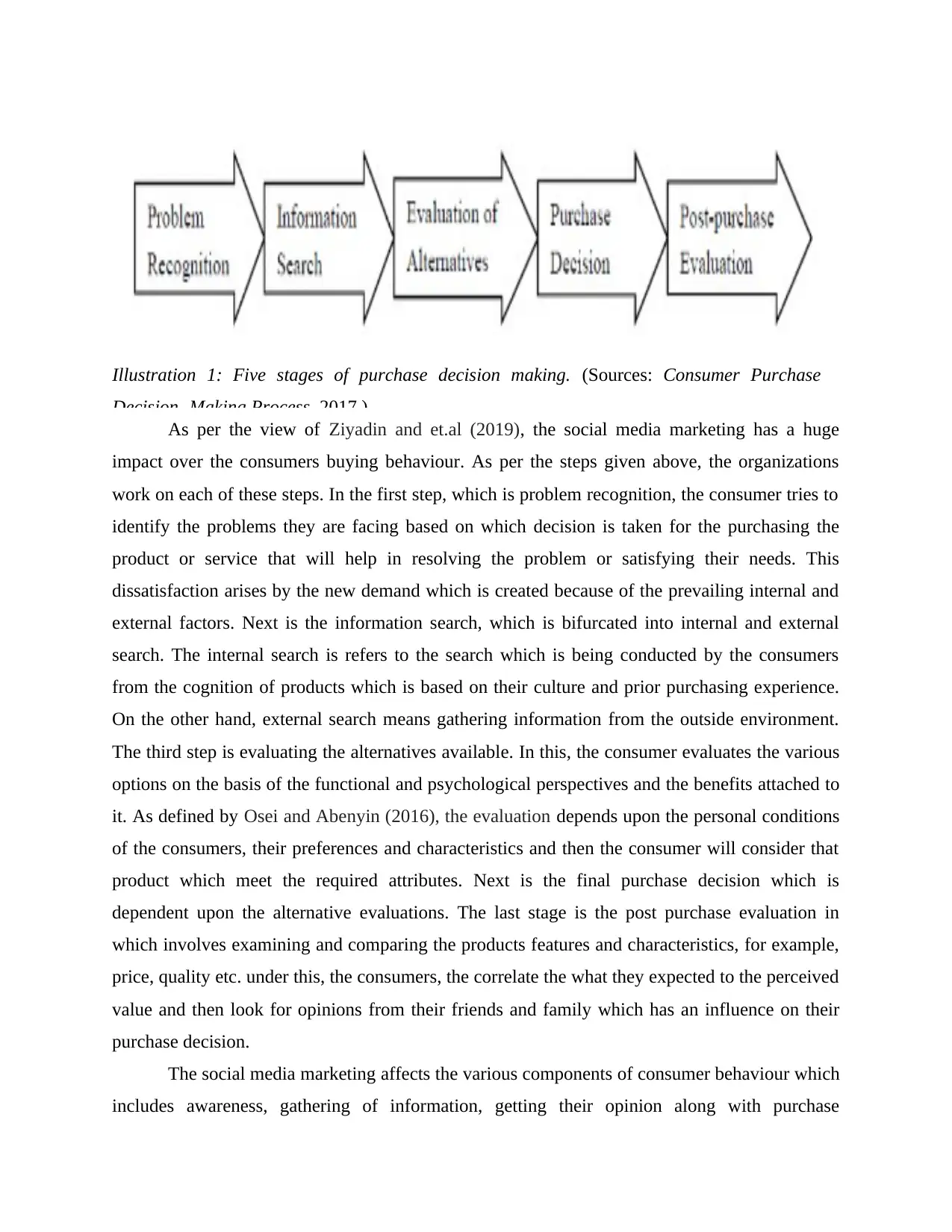
Illustration 1: Five stages of purchase decision making. (Sources: Consumer Purchase
Decision- Making Process. 2017.)
As per the view of Ziyadin and et.al (2019), the social media marketing has a huge
impact over the consumers buying behaviour. As per the steps given above, the organizations
work on each of these steps. In the first step, which is problem recognition, the consumer tries to
identify the problems they are facing based on which decision is taken for the purchasing the
product or service that will help in resolving the problem or satisfying their needs. This
dissatisfaction arises by the new demand which is created because of the prevailing internal and
external factors. Next is the information search, which is bifurcated into internal and external
search. The internal search is refers to the search which is being conducted by the consumers
from the cognition of products which is based on their culture and prior purchasing experience.
On the other hand, external search means gathering information from the outside environment.
The third step is evaluating the alternatives available. In this, the consumer evaluates the various
options on the basis of the functional and psychological perspectives and the benefits attached to
it. As defined by Osei and Abenyin (2016), the evaluation depends upon the personal conditions
of the consumers, their preferences and characteristics and then the consumer will consider that
product which meet the required attributes. Next is the final purchase decision which is
dependent upon the alternative evaluations. The last stage is the post purchase evaluation in
which involves examining and comparing the products features and characteristics, for example,
price, quality etc. under this, the consumers, the correlate the what they expected to the perceived
value and then look for opinions from their friends and family which has an influence on their
purchase decision.
The social media marketing affects the various components of consumer behaviour which
includes awareness, gathering of information, getting their opinion along with purchase
Decision- Making Process. 2017.)
As per the view of Ziyadin and et.al (2019), the social media marketing has a huge
impact over the consumers buying behaviour. As per the steps given above, the organizations
work on each of these steps. In the first step, which is problem recognition, the consumer tries to
identify the problems they are facing based on which decision is taken for the purchasing the
product or service that will help in resolving the problem or satisfying their needs. This
dissatisfaction arises by the new demand which is created because of the prevailing internal and
external factors. Next is the information search, which is bifurcated into internal and external
search. The internal search is refers to the search which is being conducted by the consumers
from the cognition of products which is based on their culture and prior purchasing experience.
On the other hand, external search means gathering information from the outside environment.
The third step is evaluating the alternatives available. In this, the consumer evaluates the various
options on the basis of the functional and psychological perspectives and the benefits attached to
it. As defined by Osei and Abenyin (2016), the evaluation depends upon the personal conditions
of the consumers, their preferences and characteristics and then the consumer will consider that
product which meet the required attributes. Next is the final purchase decision which is
dependent upon the alternative evaluations. The last stage is the post purchase evaluation in
which involves examining and comparing the products features and characteristics, for example,
price, quality etc. under this, the consumers, the correlate the what they expected to the perceived
value and then look for opinions from their friends and family which has an influence on their
purchase decision.
The social media marketing affects the various components of consumer behaviour which
includes awareness, gathering of information, getting their opinion along with purchase
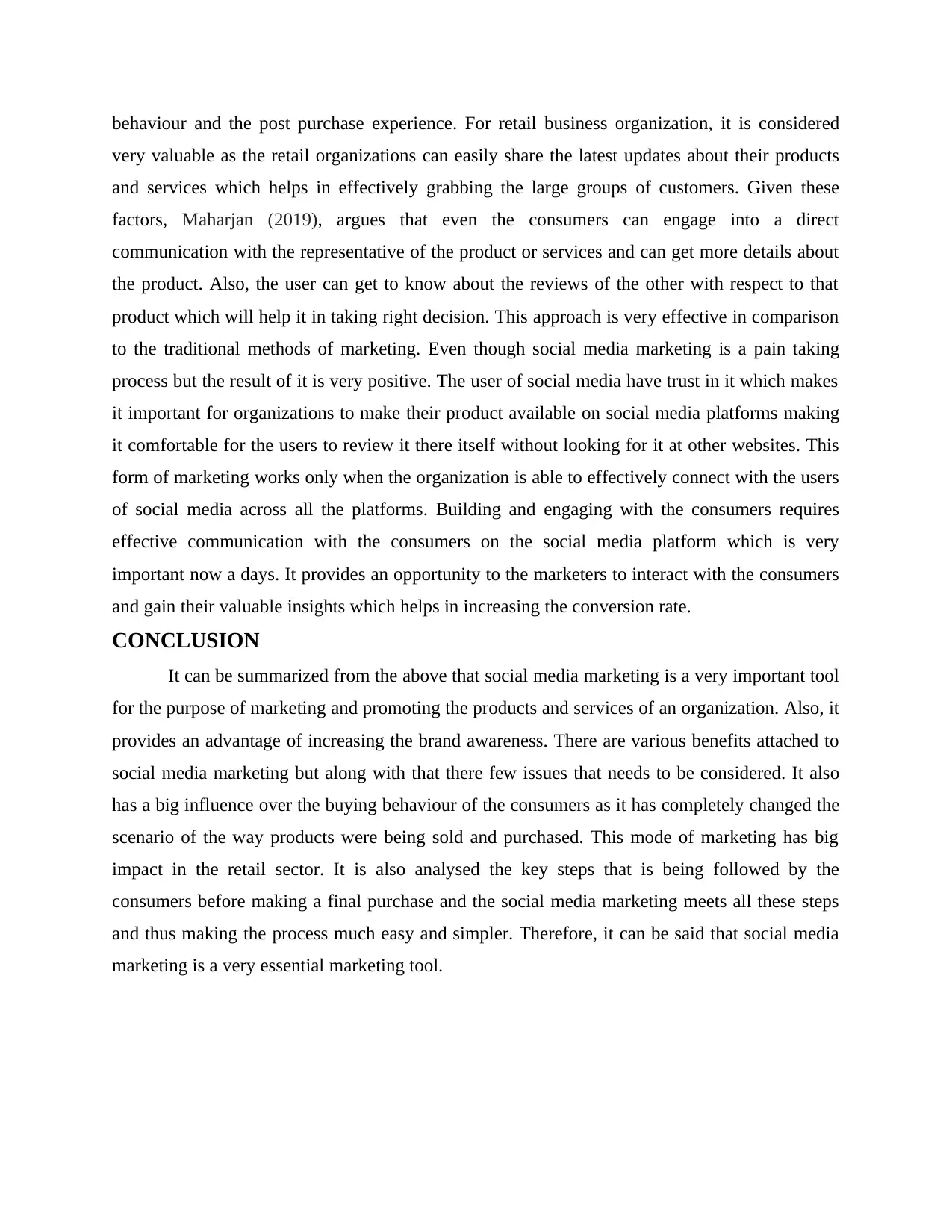
behaviour and the post purchase experience. For retail business organization, it is considered
very valuable as the retail organizations can easily share the latest updates about their products
and services which helps in effectively grabbing the large groups of customers. Given these
factors, Maharjan (2019), argues that even the consumers can engage into a direct
communication with the representative of the product or services and can get more details about
the product. Also, the user can get to know about the reviews of the other with respect to that
product which will help it in taking right decision. This approach is very effective in comparison
to the traditional methods of marketing. Even though social media marketing is a pain taking
process but the result of it is very positive. The user of social media have trust in it which makes
it important for organizations to make their product available on social media platforms making
it comfortable for the users to review it there itself without looking for it at other websites. This
form of marketing works only when the organization is able to effectively connect with the users
of social media across all the platforms. Building and engaging with the consumers requires
effective communication with the consumers on the social media platform which is very
important now a days. It provides an opportunity to the marketers to interact with the consumers
and gain their valuable insights which helps in increasing the conversion rate.
CONCLUSION
It can be summarized from the above that social media marketing is a very important tool
for the purpose of marketing and promoting the products and services of an organization. Also, it
provides an advantage of increasing the brand awareness. There are various benefits attached to
social media marketing but along with that there few issues that needs to be considered. It also
has a big influence over the buying behaviour of the consumers as it has completely changed the
scenario of the way products were being sold and purchased. This mode of marketing has big
impact in the retail sector. It is also analysed the key steps that is being followed by the
consumers before making a final purchase and the social media marketing meets all these steps
and thus making the process much easy and simpler. Therefore, it can be said that social media
marketing is a very essential marketing tool.
very valuable as the retail organizations can easily share the latest updates about their products
and services which helps in effectively grabbing the large groups of customers. Given these
factors, Maharjan (2019), argues that even the consumers can engage into a direct
communication with the representative of the product or services and can get more details about
the product. Also, the user can get to know about the reviews of the other with respect to that
product which will help it in taking right decision. This approach is very effective in comparison
to the traditional methods of marketing. Even though social media marketing is a pain taking
process but the result of it is very positive. The user of social media have trust in it which makes
it important for organizations to make their product available on social media platforms making
it comfortable for the users to review it there itself without looking for it at other websites. This
form of marketing works only when the organization is able to effectively connect with the users
of social media across all the platforms. Building and engaging with the consumers requires
effective communication with the consumers on the social media platform which is very
important now a days. It provides an opportunity to the marketers to interact with the consumers
and gain their valuable insights which helps in increasing the conversion rate.
CONCLUSION
It can be summarized from the above that social media marketing is a very important tool
for the purpose of marketing and promoting the products and services of an organization. Also, it
provides an advantage of increasing the brand awareness. There are various benefits attached to
social media marketing but along with that there few issues that needs to be considered. It also
has a big influence over the buying behaviour of the consumers as it has completely changed the
scenario of the way products were being sold and purchased. This mode of marketing has big
impact in the retail sector. It is also analysed the key steps that is being followed by the
consumers before making a final purchase and the social media marketing meets all these steps
and thus making the process much easy and simpler. Therefore, it can be said that social media
marketing is a very essential marketing tool.
⊘ This is a preview!⊘
Do you want full access?
Subscribe today to unlock all pages.

Trusted by 1+ million students worldwide
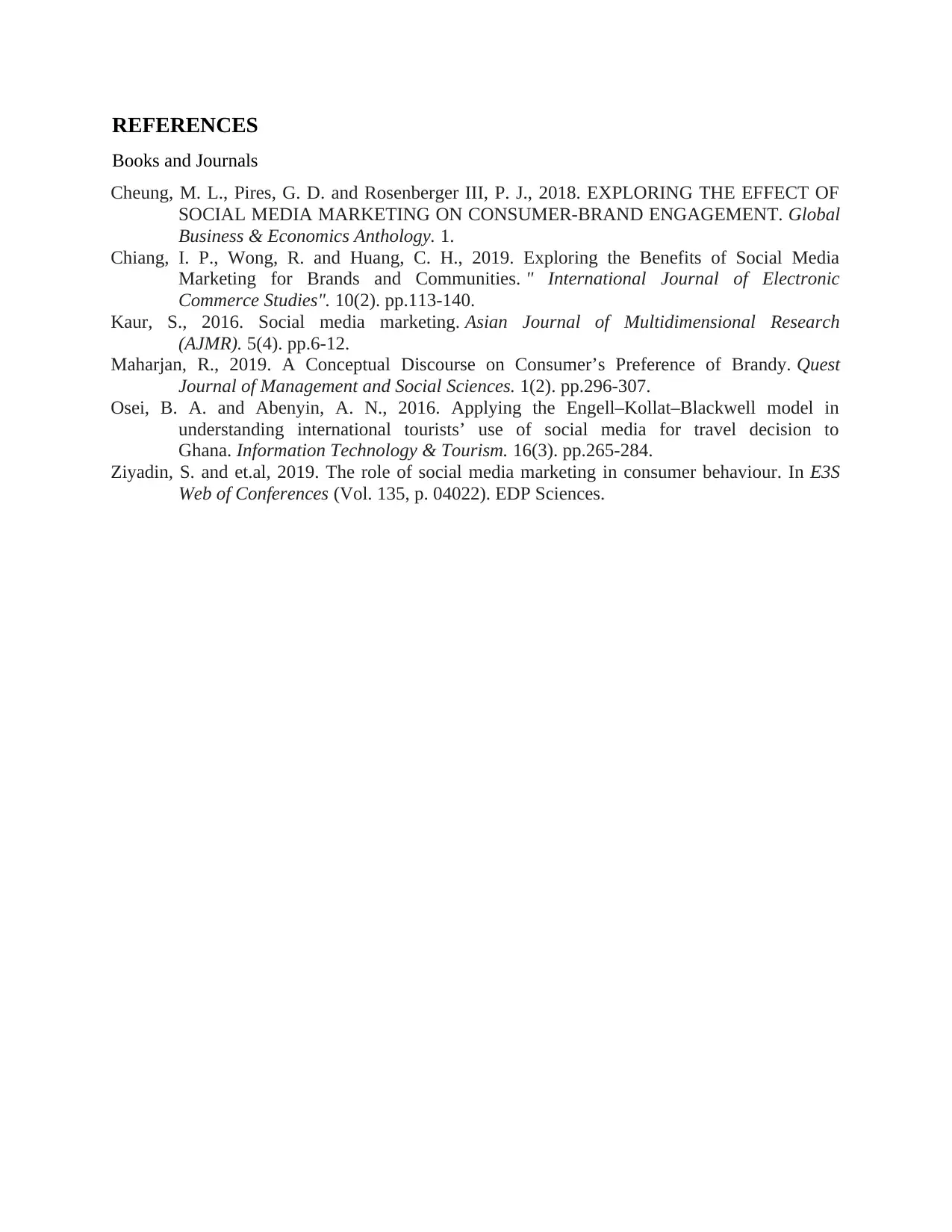
REFERENCES
Books and Journals
Cheung, M. L., Pires, G. D. and Rosenberger III, P. J., 2018. EXPLORING THE EFFECT OF
SOCIAL MEDIA MARKETING ON CONSUMER-BRAND ENGAGEMENT. Global
Business & Economics Anthology. 1.
Chiang, I. P., Wong, R. and Huang, C. H., 2019. Exploring the Benefits of Social Media
Marketing for Brands and Communities. " International Journal of Electronic
Commerce Studies". 10(2). pp.113-140.
Kaur, S., 2016. Social media marketing. Asian Journal of Multidimensional Research
(AJMR). 5(4). pp.6-12.
Maharjan, R., 2019. A Conceptual Discourse on Consumer’s Preference of Brandy. Quest
Journal of Management and Social Sciences. 1(2). pp.296-307.
Osei, B. A. and Abenyin, A. N., 2016. Applying the Engell–Kollat–Blackwell model in
understanding international tourists’ use of social media for travel decision to
Ghana. Information Technology & Tourism. 16(3). pp.265-284.
Ziyadin, S. and et.al, 2019. The role of social media marketing in consumer behaviour. In E3S
Web of Conferences (Vol. 135, p. 04022). EDP Sciences.
Books and Journals
Cheung, M. L., Pires, G. D. and Rosenberger III, P. J., 2018. EXPLORING THE EFFECT OF
SOCIAL MEDIA MARKETING ON CONSUMER-BRAND ENGAGEMENT. Global
Business & Economics Anthology. 1.
Chiang, I. P., Wong, R. and Huang, C. H., 2019. Exploring the Benefits of Social Media
Marketing for Brands and Communities. " International Journal of Electronic
Commerce Studies". 10(2). pp.113-140.
Kaur, S., 2016. Social media marketing. Asian Journal of Multidimensional Research
(AJMR). 5(4). pp.6-12.
Maharjan, R., 2019. A Conceptual Discourse on Consumer’s Preference of Brandy. Quest
Journal of Management and Social Sciences. 1(2). pp.296-307.
Osei, B. A. and Abenyin, A. N., 2016. Applying the Engell–Kollat–Blackwell model in
understanding international tourists’ use of social media for travel decision to
Ghana. Information Technology & Tourism. 16(3). pp.265-284.
Ziyadin, S. and et.al, 2019. The role of social media marketing in consumer behaviour. In E3S
Web of Conferences (Vol. 135, p. 04022). EDP Sciences.
1 out of 7
Related Documents
Your All-in-One AI-Powered Toolkit for Academic Success.
+13062052269
info@desklib.com
Available 24*7 on WhatsApp / Email
![[object Object]](/_next/static/media/star-bottom.7253800d.svg)
Unlock your academic potential
Copyright © 2020–2025 A2Z Services. All Rights Reserved. Developed and managed by ZUCOL.





